Ubisoft
Avatar: Frontiers of Pandora - a wonderful but flawed trip to Pandora
Fans of James Cameron’s Avatar series have their best chance at visiting the wonderful world of Pandora, but how good of a game is it, actually? Here’s our review for Avatar: Frontiers of Pandora
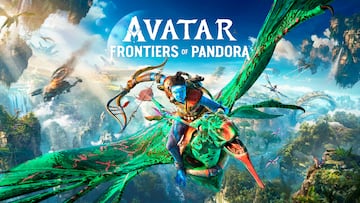
If you’ve been a fan of James Cameron’s cinematic experiment that single-handedly helped evolve the movie industry over a decade ago, you already know you’ll be playing this game. There is simply no way to deny that Avatar: Frontiers of Pandora is one of the best experiences for fans of the movie series, not to mention the closest we’ll probably get to exploring the beautiful landscapes of the alien moon. But apart from its admittedly great looks, how does it compare to the rest of the heavy hitters of 2023? Or to the movies even?
When looked at from afar, be it in trailers and screenshots, it’s clear that the developers have taken lots of care to accurately represent what Cameron has shown in the big screen. Using the power of the current generation, the moon of Pandora has some of the best looking, densely populated virtual landscapes that we’ve seen in the past few years, with the capability of getting lost in the jungles, rivers, and quite varied regions of the Western Frontier. But the closer you get to it, the truth of it all being superficial starts to become clear: under the surface you’ll find a “by-the-book” Ubisoft open-world formula, filled with way too many features that soon enough become nothing but noise.
The unseen frontier is awe inspiring
As mentioned above, it is impossible to even suggest that Frontiers of Pandora is a bad game. Far from it, the detail and care that the devs at Massive Entertainment have poured into it is wonderful. Considering the scale of the map you’ll get to explore, full of dense jungles, wide open alien plains, mountains of both the grounded and floating types, and all sort of in-between biomes, the detail and visual fidelity of the game is staggering.
The many Na’vi you encounter throughout the adventure are differentiated by the way they dress, each tribe you visit having their own styles of decorations and quite unique homes. All in all, the design of the world is great to explore and observe, like flying through the clouds on your Ikran (a dragon/pterodactyl that works as your flying mount) while a storm is pounding the ground with water and thunder, then eventually breaking through the rain to fly over the clouds with the sun shining bright on you, with calmer winds and epic music in the background.
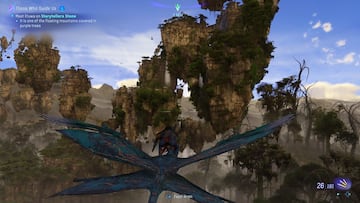
Every environment of the game could be used as a background, and it’d work great. But once you’re actually in gameplay, things start to break down a little. The biggest drawback of having such a heavy game (aside from its colossal download size that is sure to hog a big part of the storage in your Xbox Series X, PlayStation 5, or PC) is the sacrifices that had to be made to accommodate all of the visuals.
For example, the animation in cutscenes is decent, with Na’Vi children climbing around a barracks and standing up to their human captors, but as soon as gameplay begins everyone moves stiffly and unnaturally. Faces and expressions are basically nonexistent, with Human an Na’Vi flapping their mouths and squinting out of sync with what they’re saying, aside from the main villains and a couple of characters. And that is nothing to say of their characterization or voice acting, which does it best despite a less than ideal script that results in stereotypical characters splattered all over the title.
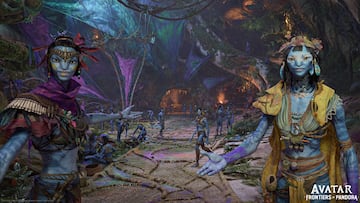
But for that, we’ll have to dig a bit more into the other biggest pull of the game, and what a huge chunk of the marketing was focused on: the story.
A ‘Canon’ story of the Avatar series…
Set at some point in and around the Avatar films, yet conveniently localized to an entirely different (yet identical looking) region of Pandora, Frontiers tell the story of a group of Na’Vi that were raised in captivity, managing to escape from their captors and rediscovering their heritage to become like their ancestors once again. The evil RDA is back after the revolution seen in the first movie, and start to contaminate the planet and treat the native habitants of the moon as savages, destroying everything in their path in the name of resource extraction.
These Na’Vi children turn out to be the last remnant of a lost tribe, the Sarentu, who once traveled Pandora telling stories and connecting all of the other tribes. Now the rebellion hopes that by rediscovering their ancestry they’ll be able to unite the scattered tribes to fight against the RDA and expel them from the planet.

The story is interesting enough to jumo into the game, exploring the land and meeting other groups of natives while fighting the humans and their mechs. Unfortunately, unless you’re a hardcore fan you’ll be faced with the reality that none of the individuals in the story are actually interesting or unique enough to be remarkable. Their language is only used for short phrases as a way of making callbacks, and for their naming conventions that result in many different characters have extremely similar names. Or on the other side of the spectrum, your Human allies have simple common names like Grace, or Priya. The bad guy? Oh, that’s just John Mercer, RDA executive.
And speaking of the opposing force, it’s been far too long since a faceless, deadpan depiction of evilness was seen as the main bad guys outside of a Call of Duty campaign. The RDA has two main antagonists: the previously mentioned John Mercer and General Angela Harding, and they’re basically there because the story figured they needed to have them there. Apart from a quick appearance during the intro, Mercer is basically absent from the plot. He is quickly replaced by Harding as the stereotypical ultra-militaristic individual, who is also never actually there, instead being relegated to videocalls and audio logs that help build their “mythos”. But their absence is felt throughout the story as they are constantly referenced as the culprits of everything around them, while never actually confronting you in any meaningful way.
You spend the entirety of the game fighting against foot soldiers, mechs, and airships, who aside from dropping a few battle quips have no personality. There are no boss fights, no remarkable enemies, and the enemy variety is actually so small that by the end of the first fight after getting your first weapon you’ll have seen around 40% of the types of enemies in it.

The plot even begins to show its rough edges when you play for extended periods of time. For example, new skills are unlocked by communing with special flowers, hooking up your Na’Vi braid-tentacle to connect with Eiwa (the essence of the planet, basically). This allows your character to have visions of their ancestors, the lost Sarentu tribe, who then proceed to give you their wisdom, such as the ancient arts of Double Jumping and… Punching robots and pulling the pilots out… It’s all a bit silly, and in the end it makes the entire thing seem like a low-budget retelling of the actual movies.
Good gameplay, but nothing you haven’t seen before
On the mechanical side of things, it’d be wrong to say that that the gameplay is boring or flawed. The truth is that running through the forest with the traversal systems that have been put into place can be quite exciting, sprinting and jumping, riding on vines to climb the huge trees in the world, and racing through strange flora and wonderful fauna. These are also a vital part of the crafting system: each material needs to be gathered by hand to collect everything needed for upgrades to your weapons, for cooking recipes, or creating new armor or mods that alter your stats.
Meat and hide can be obtained by hunting wild animals, with an in-game guide keeping track of which species carries what kinds of materials, their rarity, and detailed entries about their ecosystem, behaviors, diets, and more. Knowing how to hunt also affect the results you get from it, as a clean kill (meaning few shots from a strong bow to a weak spot) yields better quality items than gunning a beast down with a firearm or a grenade. The same goes for the many plants of the world, which have specific weather and time-of-day conditions to get the highest rarity materials.
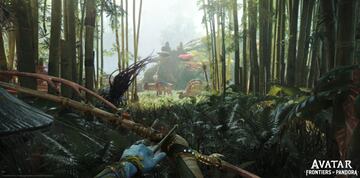
All of these systems are there to help players craft better versions of their weapons and armor, or to get temporary buffs by cooking. Your armory actually consists of a few different weapon types, but once unlocked you are thrown into the “looter-shooter” pit, always vying to get the highest damage number, resorting to replacing your weapon every couple of minutes when you find an ostensibly more powerful one on a chest inside an abandoned ruined. Suddenly, the mysticism of receiving a bow from another Na’Vi warrior is entirely gone for the sake of RPG-mechanics that feel tacked on to everything Ubisoft releases lately.
The same goes for armor, which aside from having a cosmetic factor (only to be enjoyed in a menu, unless you play co-op, as the game is First Person only) can give you small percentage buffs to your health or defense. All of this would be more interesting if the combat wasn’t so tedious and uninspired, which unfortunately, it is.
Most of your encounters with enemies will be dictated by either the story, your quests, or randomly stumbling upon one of the dozens of identical mining facilities that act as this game’s versions of “enemy camps” to be “liberated”. Instead of gaining territory, here you clear these camps to “remove pollution”. The surrounding area regains its color immediately after exploding the mining rig, and the enemies leave the area. Rinse and repeat.
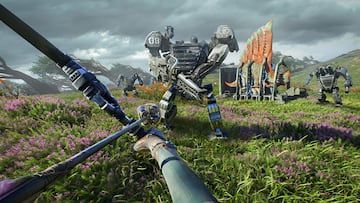
After the first few hours, you’ll have seen everything there is to be seen of the gameplay, with everything else simply being variations of the same actions over and over again. The sidequests are mostly uninspired fetch quests given to you by soulless characters in the various friendly camps, sending you to different points in the map where your rewards will commonly be random weapons and armor, or experience for the leveling system that lets you put skill points into upgrades like “one more grenade”, “10% more damage”, and “more health”. Instead, true progression is gated by the campaign giving you access to other features, like the abovementioned Ikran mount that lets you fly anywhere in the game.
Funnily enough, ground mounts are actually granted after you already have the ability to fly anywhere, and aside from being required for a few missions like the one they are unlocked, you never actually need to use them.
Feeling kind of blue
Avatar: Frontiers of Pandora is a stunning looking title that’ll take fans of the series the closest they’ve ever been to the world they first fell in love back in 2009. It’s packed full of references and information that will be enjoyed by those kind of people, the graphics are incredible, and if you already like the Na’Vi and their cultures you’ll enjoy your time with it.
But for people who are looking for innovative gameplay or an interesting experience, this isn’t the game to drop $70 on. The combat is simple and repetitive, its mission variety is entirely dependant on you being invested on the weak story, and the many systems surrounding leveling, crafting, gathering and the sort feel like busy-work meant to pad the experience for the sake of having a “bigger” game. We can’t recommend this title for anyone but the most loyal James Cameron fans.


